| |
Glossary of Coral Reef Terminology - A
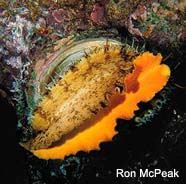
Sea otters are in direct competition with humans for abalone. (Photo: Ron McPeak)
|
abalone - a univalve mollusk (class Gastropoda) of the genus Haliotis. Abalones are harvested commercially for food consumption. The shell is lined with mother-of-pearl and used for commercial (ornamental) purposes |
abatement - reducing the degree or intensity of, or eliminating |
abaxial - away from, or distant from the axis |
abcauline - pertaining to hydrozoan polyps that extend outwards from the common stem |
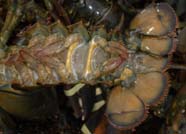
The ventral surface of the abdomen of an American lobster. Prominent are the swimmerettes, uropods, and telson.
|
abdomen - in higher animals, the portion of the body that contains the intestines and other viscera other than the lungs and heart; in arthropods, the rearmost segment of the body, which contains part of the digestive tract and all the reproductive organs |
abdominal fin - a term used to describe the location of the pelvic (ventral) fins when they are inserted far behind pectorals. This is the more primitive condition. More recently evolved conditions have the pelvic fins in the thoracic or jugular positions. A salmon, for example, has its pelvic fins in the abdominal position. An angelfish has the pelvic fins in the thoracic position, and blennies have the pelvic fins in the jugular position, anterior to the pelvic girdle |
abductor - a type of muscle whose function is to move an appendage or body part away from the body of an animal. Abductors work antagonistically with adductors |
aberrant - a term used to describe an atypical appearance or behavior in an animal or plant |
abient - avoiding or turning away from a source of stimulation |
abiogenic - refers to things not involved with or produced by living organisms |
abiotic - refers to nonliving objects, substances or processes |
ablation - the experimental removal or killing of some part of an organism |
abnormal - not normal; contrary to the usual structure, position, behavior or rule |
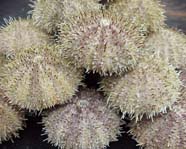
Spines protect the aboral surface of a sea urchin. (Photo: NOAA)
|
aboral - situated opposite to, or away from the mouth; normally used to describe radially symmetrical animals, such as starfishes, sea urchins, and jellyfishes |
abranchiate - lacking gills |
abrasion - the mechanical process of gradually breaking down a hard layer |
absolute tautonymy - in taxonomy, the identical spelling of a generic-group name and one of its included specific-group names, such as the fish, Badis badis, or the western lowland gorilla, Gorilla gorilla gorilla |
absolute zero - the temperature at which all motion will cease (0 degrees Kelvin or -273.15 degrees C) |
absorption - the biological process that follows digestion, by which the products of digestion are transferred into the organism's internal environment, enabling them to reach the cells |

A parasitic tapeworm is an absorptive feeder. The narrowest point is the "head" or scolex which attaches the parasite to the intestinal lining by means of suckers and/or little hooks. Predigested nutrients are absorbed through the wall of each of the progressively larger segments. These animals have no digestive canal. (Photo: HHS/Centers for Disease Control and Prevention)
|
absorptive feeder - an animal, such as a parasitic tapeworm, that absorbs digested food products through the body wall |
abundance - the number or amount of something, e.g., the number of organisms per unit of habitat space or number of individuals in a stock or a population |
abyssal plain - the ocean bottom offshore from the continental margin , usually very flat with a slight slope |
abyssal zone - the deep sea region below 2,000 meters (some consider it to be the region below 4000+ meters). This region is characterized by continuous cold, extremely high water pressure, low nutrients, and near or total absence of light, except for bioluminescence |
abyssalpelagic zone - the pelagic environment from a depth of 4000 m to 7000 m.The water temperature in this zone is constantly near freezing; also called the "abyssopelagic zone" |
acanthaceous - being armed with spines or other pointed projections |
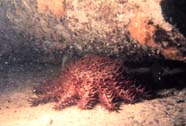
Crown-of-Thorns starfish (Acanthaster sp.), a voracious predator of corals.
|
Acanthaster - the Crown-of-Thorns starfish genus. Acanthaster planci is a voracious Indo-Pacific predator of corals |

The phylum Acanthocephala contains about 1,000 species of spiny-headed worms. All are endoparasites in the intestinal tract of vertebrates, especially fishes. (Image: Dr. Rick Gillis, Biol. Dept., Univ. of Wisconsin)
|
acantho- - a prefix meaning "with spines" |
acanthocaulus - a juvenile coral of some species that is attached to the substrate either directly or on a stalk |
acanthotrich (acanthotrichium) - in fishes, a spiny dorsal or anal fin ray |
accepted name - in taxonomy, a name adopted by an author as the correct name for a taxon |
accessory pigment - a photosynthetic pigment which absorbs light and transfers energy to chlorophylls during photosynthesis |
accessory respiratory organ - in fishes, a superficial or internal organ which complements the gills in respiration when the fish is in poorly oxygenated water or in air |
accidental host - a host in which a parasite is not commonly found |
accidental parasite - a parasite in or on an organism other than its normal host; an incidental parasite |
acclimation (acclimatization) - a change that occurs in an organism to allow it to tolerate a new environment |
accretion - growth by virtue of an increase in intercellular material |
accuracy - the closeness by which a set of measurements approaches the true value |
acellular - describes the construction of an organism or tissue that is a mass of protoplasm which is not divided into cells, e.g., some structural parts of slime molds and fungi |
acerose - having a sharp, rigid point |
acetal - any organic compound formed by adding alcohol molecules to aldehyde molecules |
achelate - lacking a claw or pincer-like structure |
achromic - unpigmented; without color |
aciculate - needle-like or having needle-like parts |
aciculum - a chitinous basal seta or rod supporting the parapodial lobes in polychaete worms |
acid - a substance that increases the hydrogen ion concentration in a solution |
acid rain - the precipitation of sulfuric acid and other acids as rain. The acids form when sulfur dioxide and nitrogen oxides released during the combustion of fossil fuels combine with water and oxygen in the atmosphere |
acidic - having a pH of less than 7 |
acidification - the lowering of pH in water or soils, commonly associated with changes caused by external processes such as greenhouse gases, acid precipitation and acidic runoff. Ocean acidification is the name given to the ongoing decrease in the pH of the Earth's oceans, caused by their uptake of anthropogenic carbon dioxide from the atmosphere. It is believed that the resulting decrease in pH will have negative consequences, primarily for oceanic calcifying organisms such as corals, foraminiferans, coccolithophores, mollusks, crustaceans, and echinoderms |
acidophilia - an abnormal increase in the number of eosinophils in the blood which is characteristic of allergic states and various parasitic infections; also called "eosinophilia" |
acidophilous - having an affinity for or thriving in acidic conditions, e.g., in a bog or marsh |
aciniform - resembling a cluster of berries |

Acoelomate flatworms such as this Pseudoceros sp. lack a coelom (body cavity). (Photo: Adam Petrusek)
|
acoelomate - an animal that does not have a true coelom or body cavity, i.e., a body cavity between the outer wall and the gut and lined with mesoderm. Acoelomate phyla include the flatworms (Platyhelminthes), ribbonworms (Nemertea), and jaw worms (Gnathostomulida) |
acolonial coral - a solitary coral that does not form a colony |
acontioid - one of many adhesive threads of tube anemones situated on the lower portion of the mesenteries |
acontium - a thread-like part of a coral polyp's or anemone's digestive system and employed as defensive or aggressive structures when extruded |
acoustic scattering - the irregular reflection, refraction, or diffraction of a sound in many directions |
acoustic signature - a set of characteristics used to describe a sound signal. This may include sound echos from targets, radiated and ambient noise, with salient echo characteristics including target strength, spectral reflectivity versus frequency, doppler shift, doppler spread and target range extent |
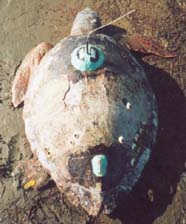
Radio tag (anterior) and acoustic tag (posterior) attached to a loggerhead turtle. (Photo: ALan Rees/ARCHELON)
|
acoustic tag - a sound transmittor attached to an aquatic animal to track its movements |
acquired - developed in response to the environment, not inherited, such as a character trait resulting from environmental effects (acquired characteristic) |
acquired character - a non-inherited character, of function or structure, developed in an organism as a result of environmental influences during the individual's life |
acre - an area equal to 43,560 square feet or 4,046.87 square meters. One square mile equals 640 acres |
acrocyst - in hydrozoans, a sac containing a completely developed planula larva |
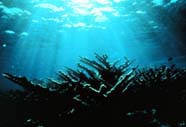
Staghorn coral (Acropora sp.).
|
Acropora - a genus of hard (stony) corals that contain the elkhorn and staghorn corals. In May 2006, NOAA's national Marine Fisheries Service decided to list elkhorn corals (Acropora palmata) and staghorn corals (Acropora cervicornis) as threatened species under the Endangered Species Act (ESA). A species is considered threatened if it is likely to become an endangered species within the foreseeable future |
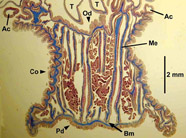
Longitudinal section of A. alicemartinae (azocarmine triple staining). Ac: acrorhagus; Bm: basilar muscle; Co: column; Me: mesenteries; Od: oral disc; Pd: pedal disc; T: tentacles (Photo:V.Häussermann & G.Försterra/U.Frankfort)
|
acrorhagus - a sac, covered with nematocysts, that protrudes from below the sweeper tentacles or on the column of certain anthozoans |
acrosome - a protrusion on the anterior end of a sperm cell that contains digestive enzymes that enables the sperm cell to penetrate the layers around the oocyte (ovum) |
acrosphere - the knobbed tentacle tip of an anthozoan, usually bearing numerous nematocysts |
acrotroch - a band of cilia anterior to the prototroch (preoral band) in larvae of polychaete worms |
actic - pertains to littoral rocky shores as a habitat |
actin - one of two proteins involved in muscle contraction. Actin assembles into long polymer rods called microfilaments which interact with the other muscle protein, myosin, to cause shortening (contraction) in muscle cells. Actin also serves as an important structural molecule for the cytoskeletons of many eukaryotic cells |
actiniform - ray-like; star-shaped |
actinobiology - the study of effects of radiation upon living organisms |
actinometer - an instrument for measuring incident radiation |
actinopharynx - a short, flagellated tube between the mouth and gastrovascular cavity of an anthozoan polyp. It arises as an invagination of the oral epidermis; the pharynx of an actinarian; also called the "stomodaeum" |
actinophore - a pterygiophore and its associated fin ray |
actinoporins - a group of proteins, derived from extracts of the tentacles of sea anemones, which are characterized by their ability to spontaneously interact with biological membranes. The cytolytic character of these proteins is currently explained in terms of a molecular mechanism involving the formation of transmembrane pores |
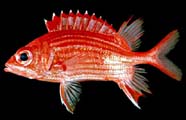
This squirrel fish is a member of the class Actinopterygii, the ray-finned fishes. Note the hard and soft rays in its fins.
|
Actinopterygii - a class of bony fishes comprising the ray-finned fishes, which make up about half of all vertebrate species known. They are found in most aquatic habitats from the abyssal depths of the ocean, greater than 10,000 m, to high altitude freshwater streams and ponds; a few species can even move about on land for short periods of time. Ray-finned fishes constitute a major human food source |
actinostome - the mouth of a radially symmetrical animal |
actinotoxin - a cytolytic toxin derived from extracts of the tentacles of sea anemones, isolated by alcoholic extraction |
actinotroch - a larval form found in the Phoronida (horseshoe worms) |

Actinula larval stage of the hydrozoan, Tubularia. (photo: BIODIDAC)
|
actinula - a hydrozoan larval stage that looks like either a polyp or medusa, depending upon whether the mouth is turned upward or downward |
action potential - the electrical signal which rapidly propagates along the membrane of the axon of nerve cells, as well as over the surface of some muscle and glandular cells. It is caused by change in membrane electrical potential, the underlying cause of which is a change in flow of ions across the membrane due to voltage-activated ion channels. It leads to an all-or-nothing action current, the nervous impulse |
activated charcoal - a porous form of carbon that acts as a powerful adsorbent. Activated charcoal is used to remove toxins from water and air, decolorize liquids, and recover solvents |
activator - a substance or physical agent that stimulates transcription of a specific gene or operon |
active efflux - in microbiology, a mechanism responsible for the extrusion of toxic substances and antibiotics outside the cell. Its importance lies in its contribution to bacterial antimicrobial resistance |
active search - search behavior in which a herbivore or predator moves around its environment looking for food |
active site - a specific region of an enzyme where a substrate binds and catalysis takes place |
active transport - the pumping of molecules or ions through a membrane against their concentration gradient.This action requires the expenditure of energy through ATP hydrolysis |
aculeate - bearing a sharp point |
aculeiform - having a sharp point; needle-shaped |
acumen - the pointed tip of the rostrum in decapod crustaceans |

The fierasfer, Carapus bermudensis, possess an acuminate shape. The tapered end allows the fish to retreat tail first, for protection, into the digestive canal of a sea cucumber when threatened. (Photo: D. Flescher, NOAA/National Marine Fisheries Service)
|
acuminate - a shape which gradually tapers to a point |
adambulacral - pertains to structures situated along the ambulacral grooves of echinoderms |
adanal - located near the anus |
adapertural - in gastropods, a location near the shell aperture |
adaptation - changes in gene frequencies resulting from selective pressures being placed upon a population by environmental factors. This results in a greater fitness of the population to its ecological niche |
adaptive behavior - any behavior that enables an organism to adjust to a particular situation or environment |
adaptive management - the process of changing a management strategy in response to measuring its success |
adaptive radiation - the evolution of a single evolutionary stock into a number of different species |
adaptive value - the degree to which a characteristic helps an organism to survive and reproduce, or affords greater fitness in its environment |
adaptive zone - a particular type of environment requiring unique adaptations then allowing adaptive radiation to occur |
adaxial - situated on the side of, or facing toward an axis |
adcauline - pertaining to hydrozoan polyps that bend towards, or are near to the common stem |
addorsal - close to, but not on the middle of the dorsal surface |
adductor - a type of muscle whose function is to pull an appendage or body part inwards, towards the body of an animal |
adeniform - gland-shaped; resembling a gland |

Diagram of the chemical structure of adenine, one of the four nitrogenous bases in DNA.
|
adenine - one of the four nitrogenous bases in DNA that make up the letters ATGC. Adenine is the "A". The others are guanine, cytosine, and thymine. Adenine always pairs with thymine |
adenosine triphosphate (ATP) - a nucleoside triphosphate, ATP is the predominant supplier of metabolic energy in living cells. ATP supplies the chemical energy to drive endergonic reactions (requiring work or the expenditure of energy), perform mechanical work, provide heat and even produce bioluminescence |
adenovirus - a group of DNA-containing viruses which cause diseases in animals. In humans, they produce acute respiratory tract infections with symptoms resembling the common cold. They are used in gene cloning, as vectors for expressing large amounts of recombinant proteins in animal cells. They are also used to make live-virus vaccines against more dangerous pathogens |
adhesion - the molecular force of attraction between two unlike materials that acts to hold them together |
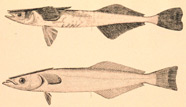
The dorsal fin of the remora (also called shark sucker or pilotfish) is modified to function as an adhesive disc (Photo: NOAA)
|
adhesive disc - in fishes, a sucker-like organ for clinging to various surfaces, e.g. the modified pelvic fins in clingfishes and snailfishes, and the dorsal fin in remoras (shark suckers) |
adhesive egg - an egg which adheres on contact to a substrate or to other eggs |
adhesive pad - an adhesive sucker located near the tip of a tentacle, in some hydrozoan medusae, utilized for clinging to plants or algae |
adiabatic process - a process which occurs with no exchange of heat between a system and its environment |
adient - tending toward or approaching a source of stimulation |
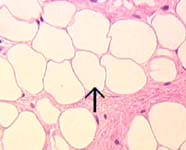
Adipose tissue. The large empty looking structures are adipocytes (fat cells). (Photo: University of Saskatuwan Biology Dept.)
|
adipocyte - a fat cell |

The adipose fin of this chum salmon lies between the dorsal and caudal fins. (Image: U.S. Fish and Wildlife Service)
|
adipose fin - in fishes, a small fleshy fin which lacks fin rays. It is found in fishes such as salmon, and most catfishes |
adjacently sympatric - pertains to those aspects of a parapatric speciation event whereby the daughter species are minimally isolated geographically |
admedial - near the medial plane |
Adobe acrobat - Acrobat Reader is a software product from Adobe, designed to view .pdf (portable document format) documents downloaded from the World Wide Web |
adoral - near or toward the mouth |
adpressed - pressed close to or lying flat against something; apressed |
adradial canal - one of eight non-branched ciliated canals which originates from the gastric pouches of scyphozoan medusae. The flow of digested food materials is toward the ring canal |
adsorbent - the solid substrate material onto which a substance is adsorbed |
adsorbtion - adhesion of an extremely thin layer of molecules to the surface of a solid with which they are in contact, as when charcoal adsorbs gases |
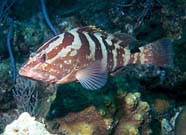
An adult Nassau grouper. It is sexually mature and capable of reproducing.
|
adult - a fully developed and sexually mature animal, physically capable of reproducing under appropriate physiological, ecological and sociobiological conditions |
advanced - new, unlike the evolutionary ancestral or primitive condition |
advection - the transport of substances in a fluid by the flow of that fluid |
adventitious - accidental or acquired; not natural or hereditary; found somewhere other than in the normal or usual place; additional |
adventitious root - a root that originates from any part of the plant other than the root system |
adventive plant - a species of plant that has been introduced into an area but has not become permanently established |
aeolian - pertaining to the erosion, transport, and deposition of materials by wind |
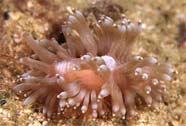
Aeolid nudibranchs lack gills and utilize their dorsal cerata for respiration and defense. (Photo: Dr Bill Rudman)
|
aeolid nudibranch - a type of nudibranch (order Nudibranchia) in which the mantle is extended into long finger-like projections, the cerata (sing: ceras), rather than a feather-like external gill on the dorsal surface. The cerata contain branches of the digestive gland. The tips of the cerata contain cnidosacs which usually store nematocysts that are obtained from ingested cnidarian prey, such as hydroids, sea anemones and soft corals. If threatened, the nudibranch is capable of discharging these stinging cells through a terminal pore in the ceras. This action is an effective deterrent to predators |
aeration - the addition of air to a liquid |
aerenchyma - a specialized parenchymous tissue in seagrass leaves that has regularly arranged air spaces or lacunae. These internal air spaces serve for flotation and exchange of gasses |
aerial photography - photographs taken from an aircraft or satellite utilized to interpret environmental conditions and geographic features |
aerial root - a root which grows out from the stem above ground level |
aerobic - deriving energy from a process requiring free oxygen |
aerobic respiration - a form of respiration in which molecular oxygen is consumed and carbon dioxide and water are produced |

Three antennular segments with pairs of aesthetasc sensilla on their ventral surfaces. (Photo: Deforest Mellon, Ph.D./University of Virginia)
|
aesthetasc - an array of small hairs which contain chemosensory neurons (e.g., olfactory neurons) on a branch of the antennules of malacostracan crustaceans, such as lobsters, crabs, and mantis shrimp |
aesthete - unique to chitons (Polyplacophora -Mollusca), aesthetes are photosensitive mantle cells, present in very high densities. Although they are involved in light responses, their exact function is unknown |
afferent - refers to a structure that leads to or toward a given position. For example, The portion of the peripheral nervous system that carries information from the organs and tissues of the body to the central nervous system (brain or nerve cord) or a small artery that carries blood to the filtration system of the kidney |
affinity index - a measure of the relative similarity of the composition of two samples. Reciprocal affinity is a measure of distance |

Sunrise as viewed from the aft deck of the NOAA Ship Albatross IV. (Photo:NOAA)
|
aft - in, near, or toward the stern (rear) of a vessel |
agamogenesis - reproduction without fertilization by a male gamete; parthenogenesis |
agamospecies - species which replicate asexually |
agar - a gelatinous material extracted from the walls of some red algae, mainly species of Gelidium and Gracilaria. Agar is used as a support medium, when supplemented by appropriate buffers and/or nutrients and other ingredients, for cultures of microrganisms and tissues, electrophoresis, etc |
age class - a group of individuals of a species all of the same age |
age distribution - the frequency of different ages or age groups in a given population |
age structure - the relative proportion of individuals in each age group in a population |
agglomerate - to group or gather together in a dense cluster |
agglutinate - clumped together, as if by glue |
aggregate - a group of species, other than a subgenus, within a genus, or a group of subspecies within a species. An aggregate may be denoted by a group name |
aggregate - a collection of units or particles forming a body or mass (noun); to form such a body or mass (verb) |
aggressive mimicry - a type of mimicry which results in a deceived species being preyed upon or parasitized by a predator species. The mimic's cues may be visual, auditory, olfactory or behavioral |
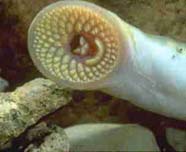
The mouth of a jawless agnathan, the sea lamprey. Adults feed by attaching themselves to their prey, rasping a hole in the skin, and consuming blood and body fluids. (Photo: Minnesota Sea Grant)
|
Agnatha - agnathans are the most primitive and ancient of the vertebrates. As the name "Agnatha" implies, they lack jaws. Paired fins are also generally absent, and the the adult retains the notochord. The skeleton is cartilaginous. The agnathans include the lampreys and hagfishes |
agonist - in pharmacology, a molecule that triggers a cellular response by interacting with a receptor |
agonistic behavior - aggressive, negative behaviors, such as fighting, threatening, and fleeing |
agricultural land - land managed for crops, pasture, or other agricultural use |
agricultural pollution - the liquid and solid wastes from all types of farming, including runoff from pesticides, fertilizers and feedlots; erosion and dust from plowing, animal manure, carcasses, crop residues and debris |
agricultural run-off - the drainage of water from agricultural land |
agroforestry - a land-use system combining agriculture and forestry where trees and crops are interplanted |
aground - touching, resting or lodged on the bottom of shallow water. The opposite is "afloat" |
AGRRA (Atlantic and Gulf Rapid Reef Assessment) - an international collaboration of scientists and managers aimed at determining the regional condition of reefs in the Western Atlantic and Gulf of Mexico |
Agulhas ring - large pulses of warm and salty water of Indian Ocean origin which enter the Atlantic Ocean directly south of the Cape of Good Hope in the form of anticyclonic eddies. The process of ring detachment is associated with perturbations of the Agulhas Current that retroflects south of Africa |
ahead - in front of, or forward of the vessel |
ahermatypic coral - a coral that lacks zooxanthellae and does not build reefs |
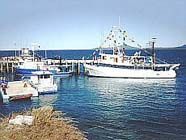
AIMS field operations jetty at Cape Ferguson. (Photo: AIMS)
|
AIMS (Australian Institue of Marine Science) - the Australian Institute of Marine Science (AIMS) was established by the Commonwealth government in 1972 to generate and transfer the knowledge needed for the sustainable use and protection of the marine environment through innovative, world-class scientific and technological research. It is a federally-funded and independent statutory authority governed by a Council appointed by the Australian government. AIMS has its headquarters at Cape Ferguson, 25km east of Townsville in North Queensland |
air bladder - an air sac located in the coelomic cavity of many fishes. In some fishes it may retain a tubular connection with the pharynx or esophagus; also known as a gas bladder or swim bladder, it functions variously as a hydrostatic organ, a sound conductor, a sound production organ, and in respiration. It is absent in sharks and rays, and some bony fishes |
air compressor - an apparatus that compresses or pressurizes air for scuba tanks. Air is compressed from the atmospheric level (14.7 psi at sea level) to the capacity of the tank, which is generally between 2500-3000 psi |
aktological - pertaining to shallow inshore environments and communities |
aktology - the study of shallow inshore ecosystems |
albatross - any of large web-footed birds belonging to the family Diomedeidae, chiefly distributed throughout the oceans of the southern hemisphere. Albatrosses have a hooked beak and long, narrow wings |
albedo - the ratio of the amount of light reflected by an object and the amount light falling on it (incident light); a measure of the reflectivity or intrinsic brightness of an object (a white, perfectly reflecting surface would have an albedo of 1.0; a black perfectly absorbing surface would have an albedo of 0.0) |

An albino catfish. The fish's skin cells contain no dark melanin granules.
|
albinism - hereditary absence of pigment in an organism. Albino animals have no color in their skin, scales, hairs and eyes. The term is also used for absence of chlorophyll in plants. Some organisms exhibit partial albinism. White tigers, for example, possess black stripes on a white background |
albino - a pigmentless white phenotype, determined by a mutation in a gene which codes for a pigment-synthesizing enzyme |
albugineous - white colored |
alcohol - any of a class of organic compounds in which one or more hydroxyl groups are attached to a carbon compound |
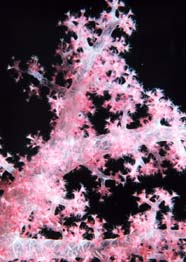
Alcyonarians are colonial soft corals that lack the CaCO3 exoskeleton of the hard or stony corals. An endoskeleton of calcareous spicules provide support for the body, which is studded with polyps.
|
alcyonarian - a soft coral of the order Alcyonacea, class Anthozoa, phylum Cnidaria. They consist of a firm body, throughout which calcareous spicules are dispersed. The surface is studded with polyps. They are closely related to the scleractinian (hard or stony) corals but lack the rigid, stony exoskeleton |
aldehyde - an organic molecule containing a -COH group. It is a colorless volatile liquid, obtained from alcohol by oxidation. An example of these aromatic compounds is formaldehyde |
alecithal - a type of egg that does not contain yolk |
Alee effect - the social dysfunction and failure to mate successfully when population density falls below a certain threshold |

Green algae are found in all aquatic environments, including marine, fresh and brackish water. (Photo: David Burdick)
|
algae - unicellular, multicellular, solitary, or colonial organisms that contain chlorophyll. They lack roots, stems, leaves, flowers, and seeds. Algae are in the Kingdom Protista |
algaecide - a chemical agent specifically designed and used to kill or inhibit the growth of algae; also called 'algicide'
algaestat - a chemical agent which retards and prevents the reproduction and growth of algae |
algal bloom - a sudden spurt of algal growth that can indicate potentially hazardous changes in local water chemistry |
algal galls - a response of gorgonia (Pseudoplexaura spp.) to tissue invasion by the algae, Entocladia endozoica, in Florida and Caribbean waters. The host gorgonia react to the algal filaments by producing capsules (galls) composed of skeletal elements that isolate the algae from the host tissue, at the expense of the skeletons' tensile strength and elasticity. The gorgonium readily breaks apart at the sites of the weakened skeleton. |
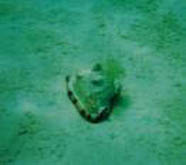
A helmet conch feeding on an algal mat in sand (Photo: James Stuby)
|
algal mat - a dense layer of algae, usually filamentous, which blankets the bottom in a shallow water environment. An algal mat can also be a ‘mat’ of microscopic species, usually diatoms, covering soft bottoms, or a mat of floating algae |
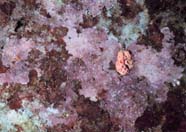
Coralline algae makes up part of an algal reef.
|
algal reef - a reef, usually exposed to wave action, composed of coralline algae and vermatid gastropods. The coralline algae occur in forms of cups or funnels |
algal ridge - a low ridge at the seaward margin of a reef flat, largely composed of skeletons of calcareous algae. A synonym of Lithothamnion ridge |
algal turf - densely packed algae, usually filamentous, which rise less than one centimeter above the substratum upon which they are growing. A synonym of turf algae |
algicolous - pertaining to an organism that lives on or around seaweed |
algin - a polysaccharide derived from brown algae. Algins are used for many industrial processes |
algophagous - refers to an organism that feeds upon algae |
algorithm - A computer program (or set of programs) which is designed to systematically solve a certain kind of problem |
alien species - a species which does not naturally occur within an area and which has usually arrived as a result of deliberate or accidental human intervention. Alien species often have adverse effects on native species as a result of competition |
alima - a larval stage of a mantis shrimp |
alimentary canal - the canal, including the stomach and intestines, leading from the mouth to the anus |
aliquot - a portion of a sample; a subsample |

A Dover sole, cleared and stained with alizarin red S, to highlight the bony structures (Photo: Natural History Museum, london)
|
alizarin - a red dye made from the roots of the madder plant, Rubia tinctorum, or produced synthetically from coal tar. A bone specific stain, alizarin red S is commonly used to stain the skeletal elements of a fish specimen. In this procedure, the muscles are rendered transparent by emersing the specimen in a caustic agent, such as potassium hydroxide |
alkaline - having a pH of more than 7. Alkaline solutions are also said to be basic |
All Islands Coral Reef Committee (AIC) - the U.S. All Islands Committee (AIC) was established in 1994 by the governor-appointed Points of Contact (POCs) from the U.S. states, territories and commonwealths of American Samoa, the Commonwealth of the Northern Marianas, Guam, Hawai`i, Puerto Rico, and the U.S. Virgin Islands. The AIC was recognized as a key element of the overall U.S. Coral Reef Initiative in Presidential Executive Order 13089 which established the U.S. Coral Reef Task Force (USCRTF) in 1998. The State of Florida joined the Committee as an Associate member in 2000 and became a full member in early 2007. Affiliate Members of the AIC are the Federated States of Micronesia, the Republic of the Marshall Islands, and the Republic of Palau |
All Islands Coral Reef Initiative - a cooperative effort among Hawaii, American Samoa, Guam, the Commonwealth of the Northern Mariana Islands, Puerto Rico, and the U.S. Virgin Islands to improve the management of coral reefs in island areas |
ALL Species Foundation - a non-profit organization dedicated to the complete inventory of all species of life on Earth within the next 25 years - a human generation (http://www.all-species.org/) |
all-or-none law - an action that occurs either completely or not at all, such as the generation of an action potential by a neuron, or the contraction of a muscle cell |
allantois - a vascularized extra-embryonic membrane of amniote embryos that forms as a narrow outgrowth of the hind portion of the gut. In birds and reptiles, it stores waste products of embryonic metabolism. The allantois fuses with the chorion to form the chorio-allantoic membrane in birds and reptiles, and a part of the placenta in mammals |
Allee's Principle - there is a positive relationship between individual fitness and either the numbers or density of conspecifics. In other words, as the number of individuals in a population increases, or as population density increases, survival and reproduction also increase |
allele - one of the variant forms of a gene at a particular locus, or location, on a chromosome. Different alleles produce variation in inherited characteristics. In an individual, one form of the allele (the dominant one) may be expressed more than another form (the recessive one) |
allelochemical - a chemical substance produced by one organism that is toxic or inhibitory to the growth or well being of another |

Schooling fish exhibit allelomimetic behavior. (Photo: Paige Gill, Florida Keys NMS)
|
allelomimetic behavior - behavioral activities that have strong components of social facilitation, imitation, and group coordination; imitation of behavioral habits of another animal, usually of the same species; behavior in social animals in which each animal does the same thing as those nearby. It is developed to a high degree in schools of fishes, flocks of birds, and and herds or pods of mammals |
allelopathic substance - a substance produced by one organism that adversely affects another organism |
allelopathy - a particular form of amensalism found in plants. In this interaction, one species produces and releases chemical substances that inhibit the growth of another species |
allergen - an antigen that provokes an immune response |
allo - - a prefix meaning other, or differing from the normal or usual |
alloantigen - an antigen that occurs in some but not other members of the same species |
allochoric - occurring in two or more communities within a given geographical region |
allochronic speciation - speciation without geographical separation through the acquisition of different breeding seasons or behavior patterns |
allochthonous population - an organism or a population of organisms foreign to a given ecosystem; they have arrived from elsewhere |
allocryptic - pertaining to organisms that conceal themselves with coverings of other organisms or with inanimate materials |
allogenic - resulting from factors acting from outside a system or material transported into an area from the outside which alters the system's habitat; genetically different individuals belonging to the same species; when describing transplantation biology, the donating individual is of the same species, but not one's self |
allogenic succession - a kind of ecological succession in which one kind of community replaces another because of a change in the environment which was external to and independent of that produced by the community itself |
allograft - a piece of tissue or an organ transferred from one individual to another individual of the same species |
allometric equation - the general form of the allometric equation is y = bxa where y = measure/process in question, x is size, a is the allometric exponent (which tells you the relationship between x & y), and b = a constant (the allometric coefficient) |
allometric growth - type of differential growth in which parts of the same organism grow at different rates. For example, in humans, the head and body grow at different rates, resulting in a human adult with completely different proportions from those of an infant |
allometry - study of the relative growth relationships between different parts of an organism; mathematically expressed by the allometric equation y = mx + b, where y = predicted size of body part; x = observed body weight; m = slope acquired; and b = the value of y where it intercepts the vertical axis. Allometry is studied during the growth of a single organism, as a comparison between different organisms of the same species, and between organisms in different species. The allometric equation is graphed on an XY axis, with the body size on the x-axis and the part size on the y-axis. The scatter produced by the different measurements being compared can then be analyzed for useful data |
allomone - a chemical substance that induces a response in an individual of another species that is beneficial to the emitting organism. Many allomones are essentially chemical deterrents. For example, a chemical substance that is produced by a prey species to repel a predator species |
allomorphosis - allometry based on the comparison of related individuals, rather than upon ontogeny. Systematic change of shape among successive adults of a phyletic sequence, for example, is allomorphosis; the rapid development of specialized organs or increase of specialization in an organism |
alloparent - an animal which exhibits parental behavior towards another animal's offspring |
allopatric speciation - speciation which occurs in populations initially isolated geographically, such as by habitat fragmentation or migration. As natural selection and genetic drift act independently in isolated populations, separation will eventually produce organisms that cannot interbreed |
allopatric species - species occupying mutually exclusive geographical areas |
allopolyploid - a type of polyploid species resulting from two different species interbreeding and combining their chromosomes |
allorecognition - the ability of an individual organism to distinguish its own tissues from those of another; the recognition of antigens, expressed on the surface of cells of non-self origin. Allorecognition has been described in nearly all multicellular phyla |
alloresponse - allorecognition, followed by the immune effector mechanisms generated by the recognition process |
allosome - a chromosome which deviates in size, form or behavior from other chromosomes. An allosome is usually a sex chromosome |
allotopic - refers to species with overlapping ranges but do not occupy the same space. They do not "live together" |
allotype - in taxonomy, a paratype of the opposite sex to the holotype |
allozyme - a form of an enzyme that differs in amino acid sequence from other forms of the same enzyme and is encoded by one allele at a single locus |
alluvial - relating to mud and/or sand deposited by flowing water |
alluvium - sediments deposited by erosional processes, usually by streams |
almost atoll - an atoll whose rim is less than 75 percent complete as a circle at low tide |
Along track Reef Imaging System (AtrIS) - a boat-mounted instrument that acquires continuous digital still EXIF-format images of shallow-marine substrates. Images are acquired via a digital still camera mounted in a waterproof housing that is deployed on a pole attached to a survey vessel. Images are instantaneously transferred to a shipboard computer and stored. AtrIS acquires high resolution, color digital images that are accurately geo-located in real-time. For a typical mission, 1,000 AtrIS images are captured per hour at a survey speed of 1 knot. AtrIS was developed by the U.S. Geological Survey |
alpha animal - in animal behavior, the individual that takes a lead role and occupies the dominant position in a group |
alpha particle - a particle emitted from the nucleus of an atom, containing two protons and two neutrons, identical to the nucleus (without the electrons) of a helium atom |
alpha taxonomy - descriptive taxonomy concerned primarily with the discovery, description, and naming of species, usually on the basis of morphological characters |
alternation of generations - a life cycle in which a multicellular diploid stage is followed by a haploid stage, and so on; found in land plants and many algae and fungi |
alternative hypothesis - in statistics, the hypothesis that is adopted when the null hypothesis is rejected |
altimeter - an instrument for measuring altitude |
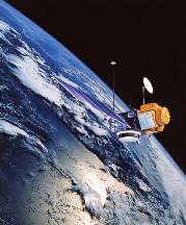
Artist's rendition of a satellite measuring altimetry.
|
altimetry - a technique to measure the height of the sea surface from radar pulses transmitted from a satellite |
altricial - born or hatched undeveloped; requiring maternal care after birth; as opposed to precocial |
altruism - a form of behavior in which an individual risks lowering its fitness for the benefit of another; in evolutionary biology, an organism is said to behave altruistically when its behavior benefits other organisms, at a cost to itself. The costs and benefits are measured in terms of reproductive fitness, or expected number of offspring |
alveolus - one of thousands of tiny air sacs at the end of the bronchioles in lungs. Alveoli are the sites of gaseous exchange between the atmosphere and the blood. Oxygen passes into the lung capillaries and CO2 passes from the capillaries into the lungs and is exhaled |

The sounds produced by the spotted boxfish, Ostracion meleagris, contribute to the ambient noise on Pacific reefs. (Photo: Hawai'i Coral Reef network)
|
ambient noise - acoustic signals originating from a variety of underwater sources, such as propeller cavitation, engine noises, animal sounds, wind, waves, and rain |
ambient pressure - the pressure surrounding an organism. On land, it results from the weight of the atmosphere. At depth, it comes from the weight of the water plus the weight of the atmosphere |
ambit - the geographic range or extent in which an organism normally lives or grows |

The ray of a starfish revealing the ambulacral groove and tube feet.
|
ambulacrum - a row of tube feet of an echinoderm |
ambush predator - a predator that hides and waits for prey to pass in close proximity rather than actively hunting for it |
amensalism - a type of symbiosis where two (or more) organisms from different species live in close proximity to one another, and where one of the members suffers as a result of the relationship while the other is unaffected by it |
amino acid - the building block of a protein. Twenty different amino acids are used to synthesize proteins. The shape and other properties of each protein is dictated by its precise sequence of amino acids. Humans must include adequate amounts of 9 of the 20 amino acids in their diet. These "essential" amino acids cannot be synthesized from other precursors |
amino acid sequence - the order of amino acids as they occur in a polypeptide chain. This is referred to as the 'primary structure' of proteins |
amino group - a nitrogen atom single-bonded to two hydrogen atoms (_NH2); imparts basic properties to an amino acid |
amitosis - an unusual form of cell division in which the nucleus cleaves without change in its component structure (such as the formation of chromosomes), followed by the division of the cytoplasm. Amitosis may occur chiefly in highly specialized cells which are incapable of long-continued multiplication, in transitory structures, and in early stages of degeneration |
ammonotelic - having ammonia as the chief excretory product of nitrogen metabolism |
amnion - a non-vascular extra-embryonic membrane of amniote embryos that forms a fluid-filled cavity surrounding the embryo. It protects the embryo by functioning as a shock absorber |
amniote - a vertebrate whose embryo is surrounded by a fluid-filled sac, the amnion; characteristic of reptiles, birds, and mammals |
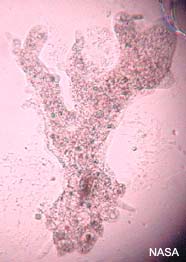
An amoeba thrusting out pseudopodia (false feet). (Photo: NASA)
|
amoeba - a-naked freshwater or marine protozoan protist that forms temporary pseudopodia for food and water capture, and locomotion - |
amoebocyte - a phagocytic cell found circulating in the body cavity of coelomates, particularly annelids and mollusks, or crawling by amoeboid movement through the interstitial spaces of sponges; an amoeboid cell in sponges that transports nutrients and is found in the matrix between the epidermal and collar cells; any cell having the shape or properties of an amoeba |
amoeboid movement - a type of motility of a cell in which cytoplasmic streaming (directional flow of cytoplasm) extrudes outward of the cell to form pseudopodia (false feet) so that the cell can change its location |
amorphous - lacking a distinct form or shape |
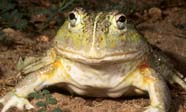
The African Bullfrog, Pyxicephalus adspersus. This amphibian is an inhabitant of Namibia. (Photo: Copyright Miguel Vences and Frank Glaw, 1998)
|
Amphibia - a class of vertebrates that consists of frogs, toads, newts, salamanders, and caecilians. These organisms live at the land/water interface and spend most of their life cycle in water. With exception of some tree frogs, all must reproduce in water or otherwise moist conditions. Amphibians are not typically marine |
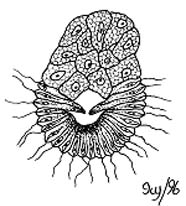
Amphiblastula larva of a sponge. (Photo: Copyright BIODIDAC)
|
amphiblastula - a sponge larva that appears as a hollow ball with anterior flagellated cells and posterior larger and nonflagellated cells (megascleres) |
amphidiploid - an allopolyploid; an organism produced by hybridization of two species followed by chromosome doubling |
amphidromous - refers to the migratory behavior of fishes moving from fresh water to the ocean and vice versa, not for reproductive purposes but occurring regularly at some stage of the life cycle |
amphimixis - sexual reproduction involving the fusion of male and female gametes and the formation of a zygote |
amphipathic - refers to molecules with both hydrophobic and hydrophilic regions. Proteins and lipids may be amphipathic |
amphophilic - having an affinity for both basic and acidic dyes |
amplicon - the DNA product of a polymerase chain reaction (PCR), usually an amplified segment of a gene or DNA sequence |
amplification - in genomics, the process of increasing the number of copies of a particular gene or chromosomal sequence |
amplified ribosomal DNA restriction analysis (ARDRA) - DNA fingerprinting based on restriction patterns of ribosomal DNA. The method consists of amplification of the 16S rRNA gene (rDNA) and subsequent restriction digestion of the amplicon |
ampulla - a membranous vesicle |
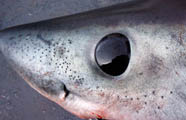
The ampullae of Lorenzini are small vesicles and pores that form part of a subcutaneous sensory network of sharks. These vesicles and pores are found around the head of the shark and are visible to the naked eye. They appear as dark spots in this photograph of a porbeagle shark head. (Photo: Dr. Steven Campana, Bedford Institute of Oceanography)
|
ampullae of Lorenzini - small vesicles and pores around the head of a shark that form part of an extensive subcutaneous sensory network system that detects weak magnetic fields produced by other fishes, at least over short ranges. This enables the shark to locate prey that are buried in the sand, or orient to nearby movement. The ampullae may also allow the shark to detect changes in water temperature |
amural form - a coral growth form in which the corallite walls are partially or wholly lost; the septa stay unreduced |
amylopectin - a highly branched polymer of glucose found in plants |
amylose - a linear polymer of glucose |
anabolism - the metabolic processes that consumes energy and involve the synthesis of larger, complex molecules from simpler ones |

The chinook salmon is an anadromous fish which spends most of its life in the ocean, but returns to fresh water streams for spawning
|
anadromous species - a species that spends its adult life in the ocean but swims upriver to freshwater spawning grounds in order to reproduce, e.g., Pacific salmon |
anaerobe - an organism that can live in the absence of oxygen |
anaerobic - deriving energy from a process that does not require free oxygen |
anagenesis - the evolutionary process whereby one species evolves into another without any splitting of the phylogenetic tree |
anaglyph - a stereoscopic picture consisting of two images of the same object, taken from slightly different angles, in two complementary colors. When viewed through colored spectacles, the images merge to produce a stereoscopic sensation, i.e., that appears three-dimensional when superimposed; anything carved in low relief |

Anal fin of a bony fish. (Photo: John Lyons, University of Wisconsin)
|
anal fin - the single fin situated on the ventral midline of a fish, behind the anus, and anterior to the caudal fin |
analgesia - the absence of pain in response to stimulation that would normally be painful |
analgesic - any drug intended to alleviate pain. Analgesics increase a patient's pain threshold, thereby decreasing the sensation of pain. Analgesics range from aspirin and acetaminophen to narcotics |
analogous behavior - behavior exhibited by different species that is similar in function, but does not originate from a common ancestry |
analogous structure - a body part that serves the same function in different organisms, but differs in structure and embryological development, e.g., the wing of an insect and a bird |
analysis of covariance - an analysis of variance in which the data are adjusted or controlled for the presence of one or more other variables |
analysis of variance - a statistical technique for testing for differences in the means of several data populations |

Fish eggs and larvae. These aquatic vertebrates do not possess an amnion during embryonic development. (Photo: NOAA/National Marine Fisheries Service)
|
anamniote - an aquatic vertebrate whose embryonic stage is not surrounded by an amnion. Fishes and amphibians are anamniotes |
anaphylaxis - a severe, potentially life-threatening, allergic reaction, which can occur after an animal sting or as a reaction to an injected drug. Less commonly, the reaction occurs after a particular food or drug has been taken by mouth. Symptoms may include vascular collapse, shock and respiratory distress; also called "anaphylactic shock" |
anastomose - a term that refers to coral branches which grow back together after the initial division |
anastomosis - the union or connecting of branches forming a meshwork or a network |
anatomy - the science of internal morphology as revealed by dissection |
ancestor - any organism, population, or species from which some other organism, population, or species is descended |
ancestral - in evolution, a trait that has been inherited unchanged from an ancestor |
ancestral polyp - an anthozoan polyp which develops from a sexually produced larva and gives rise to a colony by asexual budding |
ancestral trait - a trait shared by a group of organisms as a result of descent from a common ancestor |
ancestrula - the first (parental) zooid of a bryozoan colony, formed from a settled and metamorphosed larva. It is often smaller and morphologically distinct from the zooids that bud from it |
anchialine cave - a coastal cave formed in limestone or volcanic rock that is flooded with seawater. These marine or brackish water bodies lack surface connections to the sea. They include the longest submerged caves on Earth |

An anchialine pool, Halua Pond, located in the Ühihi-Kïna'u Reserve, Maui (Photo: Hawai'i's Natural Area Reserves System (NARS))
|
anchialine pool - a land-locked brackish body of water that displays tidal fluctuations but has no surface connection to the sea. Anchialine pools are restricted to highly porous substrates, such as recently solidified molten rock or limestone adjacent to the sea |
Andavadoaka - a small fishing village located on the southwestern coast of Madagascar. It lies on the edge of a shallow lagoon protected from the open ocean by a series of fringing and submerged barrier reefs The coral reefs, including patch reefs, in the region are in generally pristine shape, ranging from moderate to excellent. The reefs are not directly threatened by terrigenous sedimentation, as elsewhere in the country, due to the absence of major rivers. However, they are at risk from over fishing from a still small but rapidly increasing population of Vezo fishermen. Conservation efforts are currently underway to maintain the present status of these coral reefs, including the establishment of a marine protected area network encompassing parts of the barrier and patch reef systems |
androgen - a principal male steroid hormone, such as testosterone, which stimulates the development and maintenance of the male reproductive system and secondary male sexual characteristics |
androgenesis - male parthenogenesis, i.e., the development of a haploid embryo from a male nucleus. The maternal nucleus is eliminated or inactivated subsequent to fertilization of the ovum, and the haploid individual (referred to as androgenetic) contains the genome of the male gamete only in its cells |
anemochory - the dispersal of seeds, fruits, or other plant parts by wind |
anemometer - an instrument for measuring wind velocity |
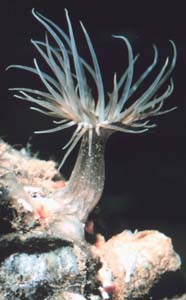
A sea anemone of the Phylum Cnidaria, Class Anthozoa. The tentacles bear stinging cells which are used for food capture and defense.
|
anemone - a cnidarian of the class Anthozoa that possesses a flexible cylindrical body and a central mouth surrounded by tentacles |
aneuploidy - the condition of having an abnormal number of chromosomes; a chromosome number that is not an exact multiple of the haploid number |
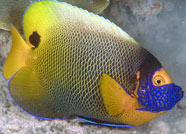
The yellowmask angelfish (Pomacanthus xanthometopon) photographed on a reef in Papua New Guinea (Photo: Tom Doeppner/Brown University)
|
angelfish - any species of colorful deep-bodied, laterally compressed, spiny-rayed fishes in the family Pomacanthidae. They resemble the closely related butterfly fishes, but generally possess a more robust body and a sharp preopercular spine. There are other kinds of unrelated fresh water angelfishes, belonging to the family Cichlidae, which are common home aquarium fishes |
angiogenesis - the growth and proliferation of new blood vessels. Angiogenesis is a normal biological process that occurs in both healthy and disease states. It is essential for the growth of tumors. Tumor cells release chemicals to encourage blood vessel growth for their nourishment |
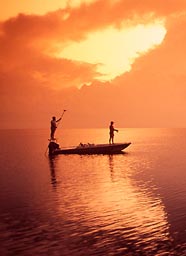
A skiff, a guide, and an angler fishing for bonefish in Florida. (Photo: Bonefish and Tarpon Unlimited)
|
angler - a person catching fish or shell fish with no intent to sell; includes people releasing the catch |
angstrom - a unit of length equal to one ten-thousandth of a micron (10-4 micron) or 10-10 of a meter |
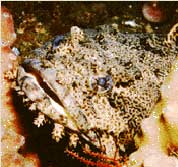
The oyster toadfish, Opsanus tau, produces sounds during the reproductive season.These sounds facilitate mating. (Photo: NOAA)
|
animal communication - animals use several ways to communicate with one another. These include the visual, auditory, and tactile senses, as well as certain chemicals involved in taste and smell. Other possibilities are magnetic fields and electrical discharges. Communication among animals helps them to recognize each other, cause reproductive behavior, and to organize social behaviors |
animal hemisphere - the half of an oocyte or egg which contains less yolk, or the corresponding half of an early embryo with the more actively dividing cells |
animal pole - the pole of a spherical oocyte or egg that is closest to the nucleus and contains most of the cytoplasm. The opposite pole is the vegetal pole, which, depending upon the type of egg, contains most of the nutritive or yolk granules. There is a graded distribution of cytoplasm and yolk along an axis between the poles that passes through the nucleus. After the fertilized egg undergoes cleavage and develops into a blastula, the same "geographic" points or reference are used |
Animalia - the kingdom of multicellular heterotrophic eukaryotes that are capable of motility during some stage of their life history |
animated GIF (Graphics Interchange Format) file - a graphic image on a Web page that moves |
anisogamous - characterized by reproducing by the fusion of gametes that differ only in size, as opposed to gametes that are produced by oogamous species. Gametes of oogamous species, such as egg and sperm cells, are highly differentiated |
ankylose - to fuse together |
anneal - the pairing of complementary DNA or RNA sequences, via hydrogen bonding, to form a double-stranded polynucleotide. It is most often used to describe the binding of a short primer or probe |

A marine segmented worm of the phylum Annelida.
|
Annelida - an animal phylum that comprises the segmented worms, and includes earthworms, leeches, and a number of marine and freshwater species |
Annual Composite HotSpot map - a map that composites all of the average monthly HotSpot (see HotSpot) images for a given year |
annulation - a circular or ring-like formation |
annulus - a mark or ring that forms annually on the otoliths, scales, and bones of fishes that correspond to the annual period of growth. Annuli can be use to determine age and growth rates of fishes |
anomaly - the deviation of a particular variable (e.g., temperature) from the mean or normal over a specified time |
anonymous work - according to the International Code of Zoological Nomenclature, a published work that does not state the name of the author(s) |
anoxic - the absence of free oxygen |
antagonistic pleiotropy - in genetics, a situation in which a single gene creates multiple competing effects, such that beneficial effects of a trait created by the gene are offset by "losses" in other traits |

A spiny lobster displaying its paired uniramous antennae and biramous antennules. (Photo: Copyright Corel Corporation)
|
antenna - one of the paired, flexible, and jointed sensory appendages on the head of a crustacean, an insect, or a myriapod (e.g., a centipede) |
antennal gland - the main organ in crustaceans used for excretion and osmoregulation; the green gland |
antennular fosette - in crustaceans, a depression, pit or socket containing the basal portion of the antennule |
antennule - a small antenna, especially the first pair of antennae in crustaceans |
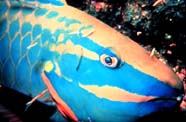
Close up of the anterior end of a spotlight parrotfish supermale.
|
anterior - morphologically, toward the head or front end of an individual, or proximal portion of a bodily part |
anteromesal - in the front and along the midline of a body |
anteroposterior axis - the longitudinal axis of an animal, from head to tail |
anthoblast - in stony corals, a young sessile polyp producing an anthocyathus, the disklike crown that separates from the stalk (anthocaulus) |
anthocaulus - a polyp that develops asexually on the skeletons of some coral species |
anthocodium - the free oral end of an anthozoan polyp, the basal portion of which is united with other zooids in a common mass; the upper tentacular part of the polyp that can be retracted into the calyx; It is a site of bioluminescence in some anthozoans |
anthocyathus - the disklike crown portion of solitary stony corals that separates from the stalk (anthocaulus) |
anthostele - the lower part of a cnidarian polyp, into which the distal portion of the polyp, the anthocodium (which includes the mouth and the tenacles) is withdrawn |
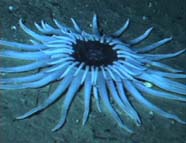
A deep-sea anemone photographed by the Alvin 2001 during a survey of Blake Ridge off the U.S. Georgia coast (Deep East expedition).
|
Anthozoa - a class of Cnidaria that includes the stony corals, soft corals, sea anemones, gorgonians, and corallimorpharians |
anthozooid - any of the individual zooids of a compound anthozoan |
anthropogenic - made by people or resulting from human activities |
anthropomorphism - attributing a human characteristic to an inanimate object or a non-human species |
anti-codon - a triplet of nucleotide bases (codon) in trNA (transfer RNA) that pairs with (is complementary to) a triplet in mRNA (messenger RNA). For example, if the codon is UCG, the anticodon is AGC |
antibiosis - an antagonistic association between two organisms in which one of the organisms is adversely affected; an association between organisms that is harmful to one of them or between organisms and a metabolic product of another; the inhibition of growth of a microorganism by a substance produced by another microorganism |
antibiotic - a chemical substance, e.g., penicillin, that kills or inhibits the growth of bacteria |
antibody - a protein produced by higher animals in response to the presence of a specific antigen |
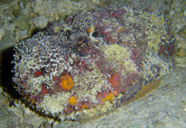
This stonefish possesses anticryptic coloration, allowing it to blend in with the surrounding environment. (Photo: David Burdick)
|
anticryptic coloration - a color or color pattern used for concealment by a predator |
anticyclone - an area of high pressure. Circulation is clockwise around the high in the Northern Hemisphere and counterclockwise in the Southern Hemisphere |
antigen - a foreign macromolecule introduced into a host organism that elicits an immune response |
antigenicity - the ability of an antigen to induce an immune response and combine with specific antibodies or T-cell receptors |
antihelmintic - a chemical agent used to combat parasitic worms, such as roundworms and tape worms |
Antillean z trap - a common type of fish trap used widely in the Caribbean and elsewhere. It takes the form of a double chevron or "Z" with two down-curving "horse-neck" entrance funnels. Typically, these measure between 180 and 230 cm in length and are 60 cm high |
Antilles Current - one of the currents of the North Atlantic subtropical gyre flowing along the northern side of the Greater Antilles. Its water is supplied from the northern branch of the North Equatorial Current, drawn mainly from the Gulf Stream recirculation. The Antilles Current merges with the Florida Current east of the Straits of Florida |
antinutrient - a compounds that inhibits the normal uptake of nutrients |
antioxidant - a molecule that is capable of reacting with free radicals and neutralizing them; a compound that slows the rate of oxidation reactions |
antioxidant - a substance that prevents cellular damage caused by free radicals, which are are highly reactive chemicals that often contain oxygen. They are produced when molecules are split to yield products that have unpaired electrons (oxidation). Antioxidants counteract the damaging effects of oxidation in body tissues |

Black coral in the order Antipatharia.
|
Antipatharia - an order of corals which contains the black and horny corals |
antipathin - a proteinaceous and chitinous material that forms the axis in an antipatharian coral |
antipodal - diametrically opposite; located on the opposite side |
antisense DNA - the strand of chromosomal DNA that is transcribed; a DNA sequence that is complementary to all or part of an mRNA molecule |
antisymmetry - a pattern of deviation without a side bias. A side difference occurs for a given trait, but the larger side varies at random among individuals |
antitoxin - a substance that neutralizes a toxin |
antivenom (or antivenin, or antivenene) - a biological product (antitoxin) used in the treatment of venomous bites and stings |
antrum - a hollow space or cavity |
anus - the posterior opening of the digestive tract, through which waste products of digestion are released |
aperture - an opening in some structure. For example, the opening in a snail's shell through which the snail emerges |
apex - the tip, top, point, or angular summit of anything |
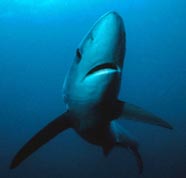
This large blue shark is an apex predator in the ocean. (Photo: Greg Skomal, NOAA/NOS National Marine Sanctuaries)
|
apex predator - a predator which is not itself preyed upon as a species. These animals are often at the end of food chains, where they have a crucial role in maintaining and determining the health of ecosystems |
aphorism - a concise statement of a general truth; a short pithy instructive saying |
aphotic zone - that portion of the ocean where light is insufficient for plants to carry on photosynthesis |
aphrioid form - a coral growth form in which the septa are reduced at their outer ends so neighbouring corallites are united by a zone of dissepiments (horizontal partitions within or outside of a corallite) |
apical - relating to or located at the tip (an apex), or opposite to the base |
apiculate - ending in a short, sharp point |
Aplacophora - a class of Mollusca. They are a small group (less than 300 species) of wormlike mollusks that lack a shell. Some are associated with soft corals. Creeping species feed on cnidarians. Burrowing species are deposit feeders and carnivores |
apobiosis - the local death of a part of an organism |

Apode fishes, such as the American and European eel (Anguilla sp), lack pelvic (ventral) fins (Photo: NOAA Photo Library collection)
|
apode fish - a fish which lacks pelvic (ventral) fins, such as the American or European eel |
apogee - the point in the orbit of the Moon or man-made satellite farthest from the Earth; the point in the orbit of a satellite farthest from its companion body |
apomixis - the asexual production of diploid offspring without the fusion of gametes. The embryo develops by mitotic division of the maternal or paternal gamete, or in the case of plants, by mitotic division of a diploid cell of the ovule |
apomixis - in flowering plants, asexual reproduction through seed |
apomorph - a derived character differing from the ancestral condition |
apomorphy - a relatively derived or advanced or unique character state |
apopinacocyte - in sponges, an endopinacocyte lining the excurrent canal |
apopinacoderm - in sponges, a surface lined with apopinacocytes |
apoptosis - a normal cellular process involving a genetically programmed series of events leading to the death of a cell; also called "programmed cell death (PCD)" or "cell suicide" |
apopyle - the opening of a choanocyte chamber of a sponge into an excurrent canal |
aporrhysa - the exhalent canals in sponges |
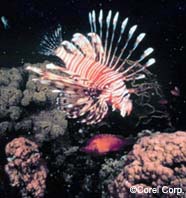
A venemous lionfish (Pterois volitans) with conspicuous coloration. (Photo: Copyright Corel Corporation)
|
aposematism - conspicuous warning coloration |
aposymbiosis - loss of a symbiont, such as zooxanthellae in hard corals |
apparent shoreline - in areas where the land is obscured by marsh grass, mangrove forests, cypress or similar marine vegetation, the actual shoreline can not be accurately represented. Instead, the outer limit line of the vegetation area is delineated (where it would appear to the eye as the shoreline) and is referred to as the apparent shoreline |
appeasement behavior - any conciliatory behavioral display. Appeasement cues often are exhibited toward threatening conspecifics when flight is either difficult or impossible; conciliation directed toward an aggressor or potential aggressor |
appendage - any body part that extends from the main axis or trunk or cephalized portion of an organism |
appendicular - relating to the appendages, as opposed to axial, which refers to the trunk and head of an organism |
applet - a small Java program that can be embedded in a web page to create special effects. Applets differ from full-fledged Java code. They are not allowed to access certain resources on the local computer such as files and serial devices, and are prohibited from communicating with most other computers across a network |
apprehensive behavior - any behavior that indicates an organism' s anticipation of an adverse or noxious experience. Some behaviors include high level of alertness, defensive postures, and threat displays |
approximate - in morphlogy, placed close together |
apron reef - the initial stage of a fringing reef. It is discontinuous and covers a small area |
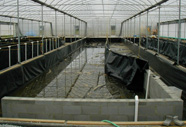
Aquaculture tanks located in in green houses. (Photo: Eileen McVey, NOAA)
|
aquaculture - the growing of aquatic organisms in controlled environments for any commercial, recreational, or public purpose; sector of fisheries that includes the rearing or raising under controlled conditions of aquatic products such as fishes, mollusks, crustaceans, sea weeds and other aquatic resources in sea, lakes and rivers. Examples are fish ponds, fish pens, and fish cages. Aquaculture is widespread, and in tropical countries has been a significant source of pollution in coastal waters and also contributes to the destruction of mangrove forests |
aquarist - a hobbiest or professional that keeps organisms in an aquarium |

The Aquarius, an underwater ocean laboratory located in the NOAA Florida Keys National Marine Sanctuary. (Photo: NOAA/OAR National Undersea Research Program)
|
Aquarius - Aquarius is an underwater ocean laboratory located in the NOAA Florida Keys National Marine Sanctuary. The laboratory is deployed three and half miles offshore, at a depth of 60 feet, next to spectacular coral reefs. Scientists live in Aquarius during ten-day missions using saturation diving to study and explore the coastal ocean. Aquarius is owned by NOAA and is operated by the National Undersea Research Center at the University of North Carolina at Wilmington |
aqueous solution - a solution in which water is the solvent |

Diagram of an aquifer system. (Diagram: Texas A&M Univ.)
|
aquifer - a subterranean layer of porous water-bearing rock, gravel, or sand capable of storing and conveying water to wells and streams |
aquiferous system - water circulatory system in sponges composed of choanoderm, pores and chambers |
Ara-A - an antiviral drug developed from the discovery of particular nucleosides (the basis of synthesis of Ara-A) in the marine sponge Cryptotethia crypta |
Ara-C - an anticancer drug developed from the discovery of particular nucleosides (the basis of synthesis of Ara-C) in the marine sponge Cryptotethia crypta |
arachnactis - a planktonic larva of tube anemones (Ceriantharia) |
Arachnida - a class of chiefly terrestrial arthropods, which includes spiders, ticks, mites, whipscorpions, pseudoscorpions, and harvestmen. Some species inhabit fresh waters and marine waters |
aragonite - a mineral species of calcium carbonate (CaCO3) with a crystal structure different from the other two forms of CaCO3 (vaterite and calcite). It is precipitated from ocean surface waters mainly by organisms (e.g., coral) that use it to make their shells and skeletons |
aragonite saturation horizon - a natural boundary in the oceans below which organisms such as stony corals cannot maintain calcium carbonate structures. As carbon dioxide levels increase, the aragonite saturation horizon becomes shallower, severely limiting the distribution of stony corals in certain parts of the deep ocean; the limit between undersaturation and supersaturation of aragonite |
aragonite skeleton - skeletons primarily composed of the aragonite form of calcium carbonate |
arborescent - having a large tree-like appearance |
arborescent colony - a coral colony with a tree-like growth structure |
arc - in a geographical information system (GIS), an arc is a line that begin and end with a node. Intersections of arcs are always connected with a node. Arcs also make up part of a polygon |
Arc/INFO - geographical information system (GIS) software developed by ESRI that is used to do more robust GIS operations |
ArcCatalog - similar to Windows Explorer, ArcCatalog was designed by ESRI to transfer ESRI and other database documents without corrupting their file structure. This program was specifically designed to recognize all the relevant files that must be transferred with shapefiles, coverages, and all of the other types of map documents |
ArcEditor - the midlevel software suite designed for advanced editing of spatial data published in the proprietary ESRI format. It provides tools for the creation of map and spatial data used in geographic information systems (GIS) |
ArcGIS - a group of geographic Information System (GIS) software product lines produced by the Environmental Systems Research Institute (ESRI) |
arch- - a prefix meaning 'ultimate beginning' |
Archaea - a group of organisms that resemble bacteria. However, these organisms are biochemically and genetically different from bacteria. Some species live in the most extreme environments found on Earth |
Archaebacteria - an ancient group of prokaryotes, over 3.5 billion years old; sometimes this group is placed into a separate kingdom, the Archaea. Most biologists currently place it within the Kingdom Monera. Archaebacteria inhabit extreme environments |
archaeocyte - in sponges, an amoeboid cell capable of phagocytosis. Archaeocytes are totipotent, having the capability of differentiating into other types of sponge cells |
archenteron - the primitive endoderm-lined gut of an animal embryo formed during gastrulation. It is formed by the invagination of blastula cells (blastomeres) into the blastocoel. The archenteron develops into the digestive tract of the adult animal |
archetype - the plan or fundamental structure on which a group of organisms, or their systems of organs, are assumed to have been constructed; as, for example, the vertebrate archetype |
archi- - a prefix meaning primitive, original, or ancestral |
archipelago - a cluster of islands usually in the open ocean. Archipelagos are often volcanic, forming along ocean ridges or hotspots. Examples of archipelagos are the Japanese islands, the Hawaiian Islands, the Philippines, and the Malay archipelago,which includes all of the islands of Indonesia |
ArcIMS - ESRI software that allows for centrally hosting and serving GIS maps, data, and applications for use on the Internet |
ArcMap - a component of ESRI's ArcGIS developed as client software specifically for the Microsoft Windows environment to enable more intuitive processing and presentation of ArcGIS data |
ArcScene - a 3D visualization application designed by ESRI that allows one to view GIS data in three dimensions |
arcuate - crescent-shaped |
ArcView - desktop geographical information system (GIS) software developed by ESRI used to do some basic GIS operations and print maps |
area cladogram - a dendrogram that displays historical relationships among geographic areas, rather than phylogenetic relationships among taxa |
arenaceous - a condition of skeletal architecture in sponges in which sand and/or foreign spicule debris partly or completely replaces native spicules within the sponge skeleton; resembling or containing sand; or growing in sandy areas |
arenicolous - living in sand |

a grouper with an areolate pattern of pigment (Photo: Agriculture, Fisheries and Conservation Department, Hong Kong)
|
areolate - appearance of a surface characterized by circular spots of tissue or areolae |

A vessel preparing to recover an ARGO float. (Photo: Japan Coast Guard)
|
ARGO Project - Argo is a global array of 3,000 free-drifting profiling floats that measures the temperature and salinity of the upper 2000 m of the ocean. This allows continuous monitoring of the temperature, salinity, and velocity of the upper ocean, with all data being relayed and made publicly available within hours after collection |
Aristotle's lantern - a highly developed chewing apparatus used for feeding in some sea urchins |
ARKive - a not-for-profit, UK-based organization whose mission is ‘to promote the conservation of nature and public appreciation of biodiversity, through the power of wildlife imagery.' by finding, sorting, cataloging and copying the key audio-visual records of the world’s animals, plants and fungi, and building them into comprehensive and enduring multi-media digital profiles (http://www.arkive.org/coral/Coral/coral.html) |
ARMDES (AIMS Reef Monitoring Data Entry System) adapted database) - a data entry and analysis program running on Microsoft Access, which enables users to input data from line transects, manta tows, and fish visual censuses into a standard access database and to carry out basic analysis of the data. It was created by AIMS and is distributed free of charge |
aromatic - a type of hydrocarbon, such as benzene or toluene, with a specific type of ring structure |
arrayed library - in genomics, Individual primary recombinant clones (hosted in phage, cosmid, YAC, or other vector) that are placed in two-dimensional arrays in microtiter dishes. Each primary clone can be identified by the identity of the plate and the clone location (row and column) on that plate. Arrayed libraries of clones can be used for many applications, including screening for a specific gene or genomic region of interest |
arrhenotoky, arrhenotokous - parthenogenetic production of haploid males from unfertilized eggs. Fertilized eggs produce viable diploid females |
arribada - a large aggregation of female sea turtles coming to shore to nest at the same place and at the same time |
ARS (autonomous replicating sequence) - any eukaryotic DNA sequence that initiates and supports chromosomal replication; also called autonomous(ly) replicating segment |
arterial gas embolism - a hazardous condition for scuba divers that is characterized by air bubbles released from ruptured lung air pockets (alveoli) into the pulmonary circulation. The bubbles then travel to the arterial circulation, where they may block blood flow in the small arteries or capillaries of the brain or heart. The results may be fatal. Arterial gas embolism in divers may be caused by holding one's breath during an ascent, wherein the lungs expand to the danger point |
artesian pressure - hydrostatic pressure of artesian water, often expressed in terms of pounds per square inch; or the height, in feet above the land surface, of a column of water that would be supported by the pressure |
artesian water - groundwater confined in an aquifer and under pressure great enough to cause the water to rise above the top of the aquifer when it is tapped by a well |
artesian well - a well tapping a confined aquifer. Water in the well rises above the top of the aquifer under artesian pressure, but does not necessarily reach the land surface; a flowing artesian well is a well in which the water level is above the land surface |
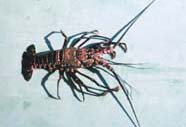
A spiny lobster (phylum Arthropoda).
|
Arthropoda - an animal phylum that contains lobsters, crabs, shrimp, mantis shrimp, barnacles and copepods, fairy shrimp (all crustaceans), insects, centipedes, millipedes, spiders, scorpions, horseshoe crabs, pycnogonids (sea spiders), ticks and mites. Approximately three quarters of a million species are described, many more than all the other animal phyla combined. The crustaceans are the arthropods associated with coral reefs |
articular - pertaining to a joint |
articulated - jointed, as in for example, the soft fin rays of fishes |
articulating - united by means of a moveable joint |
artifact - an object made by human workmanship, usually for some practical purpose |
artificial classification - in taxonomy, classification based on convenient or conspicuous diagnostic characters without attention to characters which indicate phylogenetic relationship; often a classification based on a single arbitrarily chosen character, rather than an evaluation of the totality of characters |
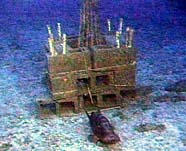
These concrete blocks were the first artificial structures deployed to provide a substrate for reestablishing colonies of Oculina coral (Oculina varicosa) and simulating fish habitat on Oculina Bank (central Florida Atlantic coast), which were destroyed by bottom trawling in the 1990s.
|
artificial reef - an artificial structure placed on the ocean floor to provide a hard substrate for sea life to colonize. Artificial reefs are constructed by sinking dense materials, such as old ships and barges, concrete ballasted tire units, concrete and steel demolition debris and dredge rock on the sea floor within designated reef sites |
artificial selection - the practice of choosing individuals from a population for reproduction (selective breeding), usually because these individuals possess one or more desirable traits |
artificial selection - a process in which humans select desireable genetic characteristics in plants and animals and selectively breed those animals and cultivate those plants to ensure that future generations of descendents have those specific desireable traits |
artisanal fishing - fishing which is typically a small-scale operation that uses simple fishing methods; fishing for subsistence by coastal or ethnic island groups using traditional methods; fishing with the purpose of catching/collecting aquatic products for sale |
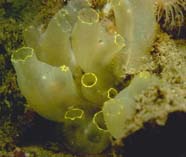
These adult ascideans (sea squirts) resemble invertebrates, but they are closely related to vertebrates and other members of the phylum Chordata.
|
ascidian - a solitary or colonial sea squirt of the phylum Chordata, class Ascidiacea. The adult form does not resemble vertebrate chordate animals but the larval stage possesses all basic chordate characteristics. Adult ascidians are sedentary, filter-feeding, cylindrical or globular animals, usually found attached to a substrate. The soft body is surrounded by a thick gelatinous to leathery test, or tunic (which also gives them the name of tunicate), often transparent or translucent. The test is secreted by the body wall of the adult animal. It is composed of cellulose, a carbohydrate unique in the animal kingdom |
ASCII (American Standard Code for Information Interchange) - a set of codes for representing alphanumeric information (e.g., a byte with a value of 77 represents a capital M). Text files, such as those created with the text editor of a computer system, are often referred to as ASCII files |
asco - a prefix meaning "sack" |
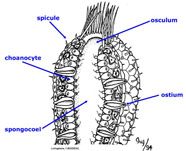
Asconoid sponges have the simplest organization. Flagellated choanocytes line the spongocoel, drawing water through small ostia and expelling it through the osculum. (Illustration: BIODIDAC)
|
asconoid - simplest body form of sponges, with canals leading directly from the surrounding water to the interior spongocoel |
ase - a suffix used for the name of an enzyme, e.g., polymerase, lipase, cellulase |
asexual embryogenesis - the sequence of events whereby embryos develop from somatic cells |
asexual reproduction - reproduction that does not involve the union of sex cells (gametes) to produce a zygote. Examples in corals are budding and fragmentation |
Asia-Pacific-Network for Global Change Research (APN) - an inter-governmental network for the promotion of global change research and links between science and policy making in the Asia-Pacific Region |
aspergilliform - brush-shaped |

A Caribbean sea fan infected with the fungus Aspergillus. (Photo: NOAA Coral Health and Monitoring Program)
|
aspergillosis - a widespread fungal infection of Caribbean soft corals. It affects six species of sea fans and sea whips. The pathogen is Aspergillus sydowii, a terrestrial fungus which infects gorgonia after germination of spores on the coral surface. This is followed by penetration and spread of hyphae in coral tissue, resulting in highly visible lesions which may be associated with complete loss of tissue and skeleton. Lesions often occur at multiple sites across an infected colony.-Purple galls may be produced by the coral host to encapsulate fungal hyphae. |
asperity - a peak or projection from a surface; pertains to roughness of a surface |
assay - in general, the qualitative or quantitative analysis of a substance to determine its constituents and the relative proportion of each, or to determine the biological, chemical, or pharmacological potency of a drug |
assemblage - a group or association of interacting populations of organisms in a given area or volume |
assimilation - the biological process of absorbing nutrients into an organism's body after digestion |
assimilation efficiency - the fraction of ingested food that is absorbed and used in metabolism |
association - a group of species living in the same place at the same time |
Association of Marine Laboratories of the Caribbean (AMLC) - AMLC is a confederation of more than 30 marine research, education, and resource management institutions endeavoring to encourage the production and exchange of research and resource management information, advance the cause of marine and environmental education in the region, and facilitate cooperation and mutual assistance among its membership. It was founded in 1956 by marine researchers with interests in the marine science of the tropical Atlantic and the Caribbean. The strength of AMLC lies in the diversity of its member laboratories and the extensive expertise of its membership |
astaxanthin - a carotenoid pigment found in crustaceans. Astaxanthins may give a green color to the musculature of fishes which feed on crustaceans |
astern - behind the vessel; toward the rear of the vessel |
asthenosphere - a layer of soft but solid, mobile rock comprising the lower part of the upper mantle from about 100 to 350 km beneath the Earth's surface |
asymmetric competition - competition between two organisms (or species) in which one is much more adversely affected than the other |
asymmetry - the lack or absence of balanced proportions between parts of a thing; without symmetry |
ata (atmosphere absolute) - one (1) ata is the atmospheric pressure at sea level |
atavism - the reapperance of an ancestral character after an interval of generations |
atmosphere - a unit of pressure, abbreviated as atm; "one atmosphere" is the pressure of the atmosphere at sea level, i.e., 760 mm Hg. Two atmospheres is twice this pressure, 1520 mm Hg, etc.; the air surrounding the earth, from sea level to outer space |
atmospheric pressure - the pressure of the atmosphere at any given altitude or location; it is synonymous with barometric pressure |
atoke - the anterior, nonreproductive part of a marine polychaete worm, as distinct from the posterior, reproductive part (epitoke) during the reproductive season |
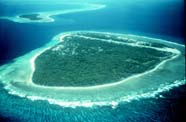
A small Pacific atoll. Note the coral reef encircling the calm and shallow lagoon.
|
atoll - a horseshoe or circular array of reef islets, capping a coral reef system that encloses a lagoon, and perched around an oceanic volcanic seamount |
atom - the smallest component of an element, made up of neutrons, protons, and electrons |
ATPase - an enzyme that functions in producing or using adenosine triphosphate (ATP) |
atresia - an abnormal condition in which a normal opening or tube in the body is closed or absent |
atrial siphon - in tunicates, the opening that carries water, wastes, and gametes from the organism. Also called the excurrent or exhalent siphon/canal |
atrichous - in Cnidaria, lacking spines or barbs |
atrichous isorhiza - in hydrozoans, a small cnidocyst (nematocyst) with a smooth tubule.These are only type of cnidocysts found in all the classes of Hydrozoa. they are never very common, but all the classes have some species with them .This type of cnidocyst occurs also in the Anthozoa, Cubozoa and Scyphozoa |
atrium - a cavity or passageway; a heart chamber which receives blood |
atrophy - a wasting or decrease in size of a tissue or organ because of a reduction in the size or number of its cells. Atrophy may result from cellular death, reduced cellular division, pressure, ischemia, malnutrition, decreased activity or hormonal changes |
attachment stage - a stage in an animal's life cycle when it ceases being free swimming or motile, and becomes attached to a substrate |
attendant male - a male fish which is not a member of a spawning pair, but hovers close by; often a sneaky male |
attitude - in animal behavior, the posture or expression assumed by an organism |
attribute - a measurable component of a biological system; a particular feature or character possessed by an organism |
auditory ossicle - one of a series of bones conducting sound in some fishes |
aulostomatous - having a tubular-shaped mouth, such as a cornetfish |
aureate - golden yellow in color |

Late-stage auricularia of Stichopus californicus - ca. 17-18 days old, raised in culture by T.H.J. Gilmour. (Photo: University of Saskatchewan Archives)
|
auricularia larva - larva of a sea cucumber; an early bipennaria larva of a starfish |
austral - relating to or coming from the south; of the south temperate region, between the antarctic and tropical regions |
Australian Centre of Excellence for Innovative science for sustainable management of coral reef biodiversity - the primary goal of this Australian Research Council Centre of Excellence is to undertake research programs of international significance (through the establishment of new collaborative teams of Australia’s leading coral reef researchers) that transcend traditional disciplinary, institutional and geographic boundaries. The Centre of Excellence cements Australia’s leading contribution to coral reef sciences, and fosters stronger collaborative links between James Cook University, The Australian National University, University of Queensland, and 28 other leading institutions in nine countries. Collectively, the JCU-led Centre creates the world’s largest concentration of coral reef scientists. The aim is to add focus, scale and scope to build an enduring program of innovative research development, leading to world leadership in coral reef science. A key outcome of the Centre of Excellence is to actively transfer scientific knowledge to industry partners and end-users, to increase their capacity and effectiveness, and provide benefits to all Australians |
autapomorphy - an apomorphy (derived character differing from the ancestral condition) possessed by a species or clade that is shared with no other species or clade, i.e., a derived character found only in a terminal taxon |
autecology - the ecology of a single species |
author - in taxonomy, the person(s) to whom a work, a scientific name, or a nomenclatural act is attributed |
authority - in taxonomy, the name of the author of a taxonomic name, cited after the name |
autochory - the process of seeds and fruits dispersal by means of some kind of explosive physical expulsion.The fruit "explodes", propelling its seeds some distance to the ground surrounding the parent plant; also called "discharge dispersal" |
autochthonous - native; indigenous; originating or occurring naturally in the place specified |
autoepizooism - settlement and growth of hydrozoan colonies on older animals of the same species |
autoevisceration - ejection of intestines and associated organs, in animals such as sea cucumbers, caused by adverse environmental conditions. Regeneration of the organs may occur within weeks |
autoimmune disease - a disease in which the organism produces antibodies against its own tissues |
autoimmunity - a condition in which an organism mounts an immune response against one of its own organs or tissues; i.e., an organism's immune system attacking its own body |
autologous cells - cells that are taken from an individual, cultured, and possibly genetically manipulated before being infused back into the original donor |
autolysis - the spontaneous disintegration of cells or tissues by the organism's proteolytic enzymes and macrophage activity, as occurs after death and in some pathologic conditions |
automated bleaching early warning system - automated bleaching alerts/warnings directly from satellite and/or in situ derived indices |
automyxis - obligatory self-fertilization |
autonomous underwater vehicle (AUV) - an unmanned, battery or fuel cell-operated underwater robot or vehicle which can operate at depths greater than 6000 meters. Autonomous underwater vehicles carry sensors to navigate autonomously and map features of the ocean floor. They should not be confused with remotely operated vehicles (ROV) that are controlled and powered from the surface by an operator/pilot via an umbilical; AUVs are also known as Unmanned Undersea Vehicles (UUV) |
autopolyploid - a polyploid formed from the doubling of a single genome |
autoradiography - a technique that uses X-ray film to visualize radioactively labeled molecules or fragments of molecules; it is used in analyzing length and number of DNA fragments after they are separated by gel electrophoresis |
autoskeleton - the endoskeleton of sponges, comprised of spicules or spongin fibers |
autosome - any chromosome that is not a sex chromosome; distinguished from a sex chromosome |
autotomy - the voluntary shedding of an appendage by snapping it off the base; in corals, some, reproduce asexually by autotomy (fragmentation), for example, Fungia sp |
autotrophic - relating to organisms that have a type of nutrition in which organic compounds used in metabolism are obtained by synthesis from inorganic compounds |
autozooecium - a tube that encloses a bryozoan autozooid |
autozooid - a feeding polyp of a bryozoan (Ectoprocta). Autozooids compose the majority of a bryozoan colony |
autumnal equinox - the equinox at which the sun approaches the Southern Hemisphere and passes directly over the equator. It occurs around September 23 |
auxesis - to grow; growth resulting from increase in cell size without cell division |
auxotroph - a polyploid formed from the doubling of a single genome |
auxotroph - an organism which is unable to synthesize a particular organic compound required for its growth. An auxotrophic alga, for example, is one which requires a few organically derived substances, such as vitamins, along with dissolved inorganic nutrients for photosynthesis; in microbiology, a mutant strain that requires a new nutrient for growth |
available name - in taxonomy, any name which conforms to all mandatory provisions of the Code. There are general requirements of publication and date, language, name formation etc. An available name is not necessarily a valid name, as an available name may be in synonymy. Conversely a valid name must always be an available one |
aversive stimulus - a noxious stimulus in its immmediate environment that an organism tends to remove or avoid |
Aves - the name of the class of vertebrates that consists exclusively of birds; the Latin word for "bird" |

Artist's rendition of POES satellite.
|
AVHRR (Advanced Very High Resolution Radiometer) - a broad-band, four or five channel (depending on the model) scanner, sensing in the visible, near-infrared, and thermal infrared portions of the electromagnetic spectrum. This sensor is carried on NOAA's Polar Orbiting Environmental Satellites (POES). AVHRR is used for studying and monitoring vegetation conditions. Applications include agricultural assessment, land cover mapping, producing image maps of large areas and tracking regional and continental snow cover. AVHRR data are also used to retrieve various geophysical parameters such as sea surface temperatures (SST) and energy budget data |
avian - of, relating to, or characteristic of birds |
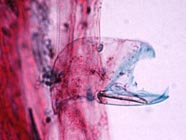
A magnified view of an avicularium from the marine colonial bryozoan Bugula sp. (Photo: Dr. Rick Gillis, Biol. Dept., Univ. of Wisconsin)
|
avicularium - a small bryozoan heterozooid in which the zooecium and operculum form a beak-like, snapping structure that deters small predators |
avifauna - the birds of a specific region or period |
avirulent - unable to cause disease |
Avogadro's number - a large constant used in chemistry and physics. It is the number of molecules (6.02214 × 10 23 )in one mole of substance; also called "Avogadro's Constant" |
AVTAS (AIMS Video transect Analysis System) - video transects are systematically sampled by identifying the benthos occurring at fixed points along the transect to the highest taxonomic level possible. The AVTAS software is used to analyse the video transects. During analysis the data are saved into a Microsoft Access¼ database. In order to eliminate confounding in data analyses due to observer biases, transects from each site are analysed by two observers. The observer who actually surveyed the reef in the field analyses transect one from site one and then every alternate transect. A second observer analyses the remaining transects |
axenic - a culture containing only one type of microorganism; not contaminated by or completely free of the presence of other organisms; a pure culture |
axial - refers to the head and trunk of an individual |
axial corallite - a corallite which forms the tip of a branch |
axial cortex - the layer around the central core of the axis of an octocoral |
axial polyp - the longest polyp of a group of polyps which produces secondary polyps by budding |
axial sheath - the coenenchyme which surrouds the axis on the Gorgonacea and Pennatulacea |
axial skeleton - in a vertebrate skeleton, the skull, vertebral column, ribs, and sternum |
axial swimming - the predominant swimming mode of fishes. This swimming movement involves lateral bending of the body caused by contractions of the lateral body musculature and oscillating movements of the caudal fin |
axis - the internal, usually calcium carbonate skeletal rod of sea fans (Gorgonacea) and sea pens (Pennatulacea) |
axis epithelium - the layer of ectodermally-derived cells which consists of corticocytes, which produce the axis, and desmocytes, which attach tissues to the axis |
axocoel - the most anterior of three coelomic spaces that appear during larval development of echinoderms |
axon - the single motor branch of a neuron that passes the nervous impulse away from the cell body to another neuron or effector organ |
axoneme - a bundle of microtubules and other proteins forming the core of each cilium or flagellum |
azooxanthellate coral - a coral which does not have symbiotic zooxanthellae in its tissues |
azure - light or sky blue color |
|
|
|
|
|

